Dora - Refrigerator
On one of our first trips with Dora, to the Oregon Coast, we traveled through the Rouge Valley where it was hot. We found the refrigerator could not keep up and was over heating. Since then we've found the 'fridge has trouble when the ambient temperature is over about 90F. That's not good since we end up in places like this a lot. We have an older Dometic RM2510 'fridge.
Several steps have been taken to improve the performance of our 'fridge.
First, a Baffle Box was put in behind the 'fridge to force flow though the 'fridge coils instead of behind them. Per the installation manual this is needed and the curve of the Escape makes for quite a gap to fill.
Second, insulate as possible around the 'fridge box. There was dead space on the sides and top. Extra insulation can't help but improve performance. It will also close the top and sides from the back, keeping hot air from circulating around the 'fridge.
Third, add fans for forced circulation. I've heard this can really help.
I pulled the refrigerator using a hydraulic lift table. It's hard to get more than one person at the 'fridge at a time and it is heavy for one old person. The lift table made removal possible. I simply pivoted it and set it on the bed (after moving the mattress). This is what the opening looks like without the 'fridge.
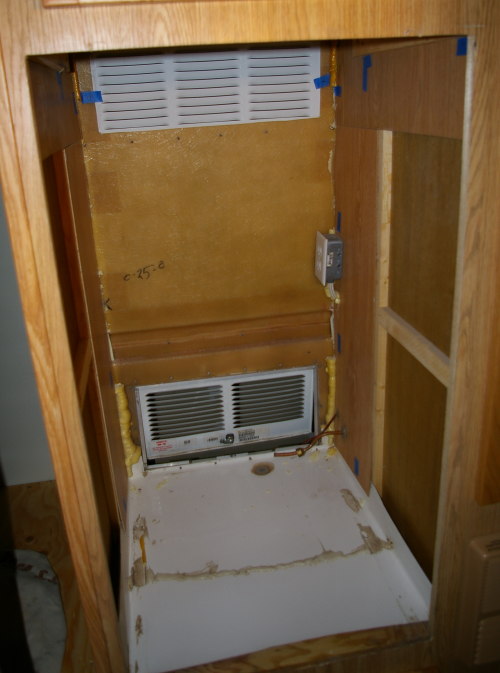
I pulled a little bit of the easily removed wall board from the side walls as seen above. This in anticipation of putting in 3/4" rigid foam insulation. In the picture below the rigid foam for the top and sides is cut and placed. Turns out there's 3/4" space on the sides and 1 3/4" on the top. That should help just by itself. The framework for the baffle box can also be seen.
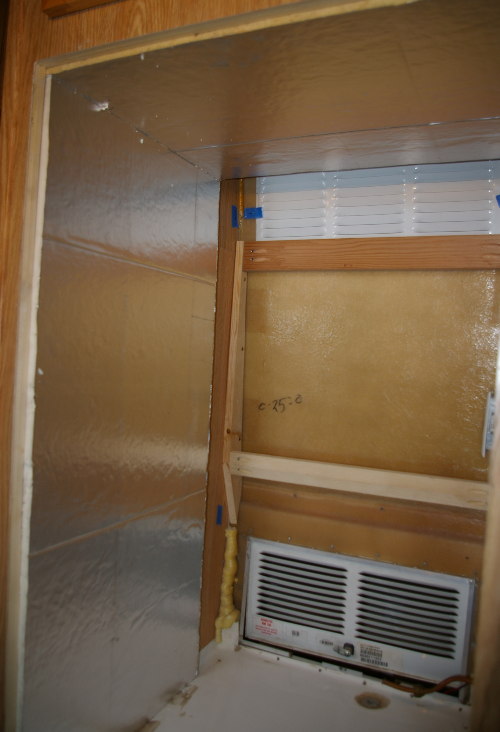
I decided to insulate the baffle box. Can't hurt. So I fixed the bottom box face in place and put in temporary top faces (coreplast) using expanding foam to insulate.
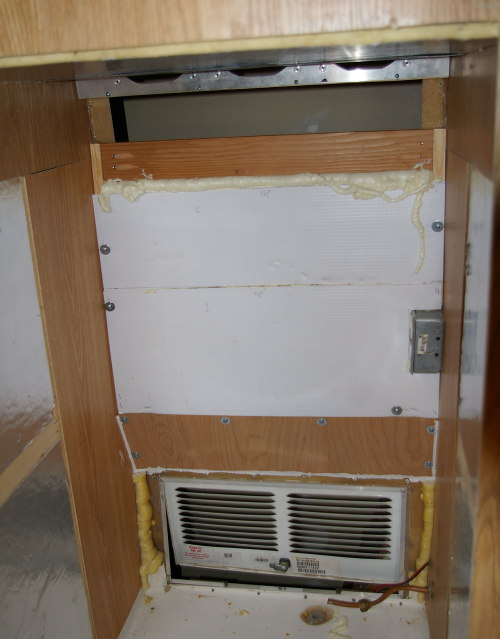
This was a marvelous idea. However, I found the expanding foam did not set-up. It seems to need air around it to set. Either I didn't wait long enough or it wasn't going to set. So, I pulled off the temporary faces and scraped out the half set foam. A nasty sticky job.

After squaring up the edges I pressed a chunk of 2" rigid foam in place. Then with a large knife and wood rasp formed it flat.

This was covered with a piece of 1/8" plywood. Note there is a cut out for the 120V 'fridge plug.
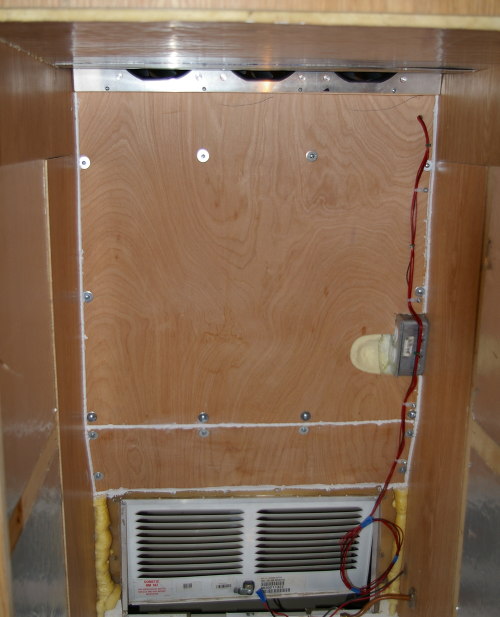
You can see the foam pressed into the side walls here. The baffle box fills about 2" of space at the bottom and maybe 1" at the top. It's a very tight fit to the back of the 'fridge when installed.
The fans fit over the top vent of the 'fridge. I debated how much room to leave around the fans for better operation without the fans running. I finally opted for none. I think leaving room would allow air to circulate through the fan, out the top vent, back in the opening in the top vent, back through the fan. Not what we want, we want the fan to pull air from the lower vent. So I opted to cover the opening with fans. Turns out three 140mm fans fit well. I came up with 12v computer case fans from NewEgg. Put these into a wood/aluminum frame to fit behind the upper vent.
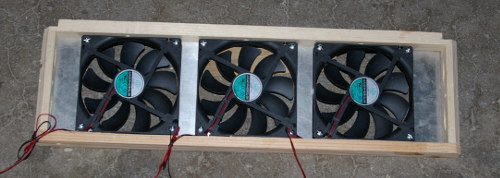
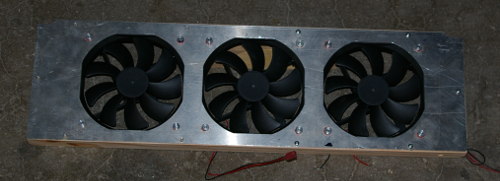
The top picture shows the side facing out. This allows fans to be changed without pulling the refrigerator. I also put in a baffle to smooth the flow into the fans.
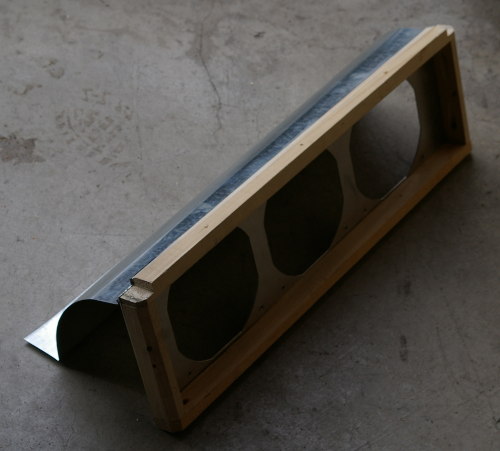
The tab on the back side fits between the 'fridge box and the top insulation. The next picture shows where the fans fit and how the tab sits up against the top insulation.

It's hard to get a good picture from the outside since the trailer is in storage. Here's the best I can do, before the outside vent goes back on.
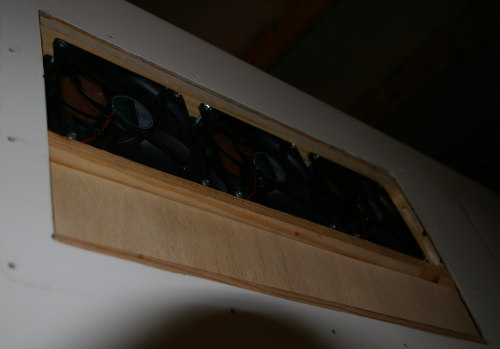
The combination of the baffle box, insulation and fans should improve performance a lot.
The final part is a fan control. We boondock now and again so battery power is precious and to be conserved. I looked around the Internet and didn't find a straight fan control. Thought about putting one together using an Arduino but didn't want to be testing it on the road. Finally settled on an ARPrv controller. It's main function is to protect the 'fridge from overheating. I wasn't looking for this function but it also controls fan(s) using a temperature sensor on the 'fridge coils.
Our Dometic RM2510 is a manual model. Not manual enough to require matches but still requires action to start. For ours it has an automatic spark, but a button must be held to start the pilot light on propane. To use the ARP on our 'fridge required a "thermocouple interrupter" and added relay. This allow the ARP to disconnect the thermocouple circuit if it detects overheating. That cuts the propane flow and stops the overheating, but once cooled off the button mentioned above must be pushed to restart the 'fridge. I believe the thermocouple is inactive when using 120V power, so the ARP has no control. But this is just an added protection for emergency overheating. I think mainly if not level and using propane. So it shouldn't turn off the propane supply unless there's an emergency, I can live with that.
The ARP could be wired to cut 12V control power to the 'fridge on overheating. This would give protection under 120V operation. However, using propane the little light would not flash telling you the pilot was off. I opted to have the light.
The fan control should work well. The temperature sensor on the coil works and the ARP has control of the fans. I did put in a switch to turn the fans on manually though, just because I'm paranoid. Here's the ARP installed in the outside 'fridge access door. Again hard to get a good picture because of the wall.
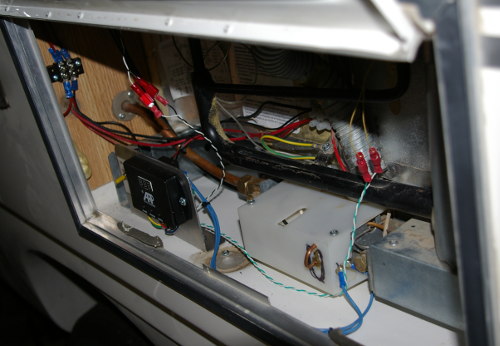
Update:
Some informal testing was done during a trip to Arizona. The temperature got into the 90s for 4-5 days. I think all the mods have helped, but not a cure all. I found it's OK up to the low 90s, like 93F. This was with the 'fridge side pointing into the sun but applied with or without a sun shade. Under these conditions the temp would decrease about 2 degrees per hour (from about 45F). So I consider it still marginal, if that.
Also, the thermocouple interruptor stopped working. With it in the circuit, and broken, the refrigerator would not work on propane. So, the interruptor was taken out. The ARP now only controls the fan.
